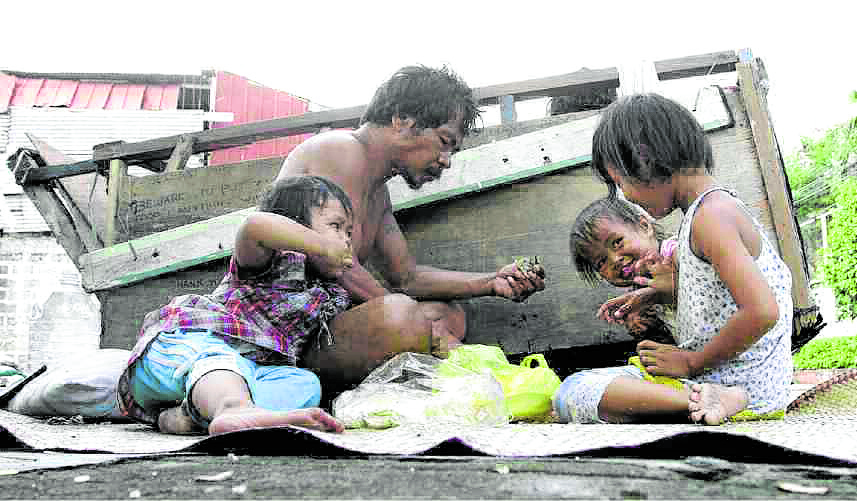PH poverty rate rose to 23.7% in H1 2021 amid expensive food, high joblessness

FILE PHOTO: Like-minded corporations and institutions have united behind the mission to reduce the number of poor and hungry Filipino families. Contributed picture
MANILA, Philippines — The prolonged COVID-19 pandemic which shed jobs and livelihoods, coupled with high consumer prices, jacked up the Philippines’ poverty rate to 23.7 percent in the first half of 2021, the government reported Friday.
National Statistician Dennis Mapa said the increase in poverty incidence at the start of the year reversed the downward trend during the preceding three rounds of the first-semester family income and expenditures survey (FIES) being conducted by the Philippine Statistics Authority (PSA) every three years.
From the first-half rate of 27.9 percent in 2012, poverty slightly declined to 27.6 percent in 2015, and then dropped to 21.1 percent in 2018, Mapa said.
The increase in poverty incidence among the population during the first half meant an increase in the number of poor Filipinos to 26.14 million from 22.26 million three years ago before the COVID-19 pandemic struck.
Mapa said the latest FIES results showed that the poverty threshold — the estimated minimum monthly cost that covered basic food and non-food needs of a family — rose 14.7 percent to P12,082 per household from P10,532 in 2018.
It did not help that food items, especially meat like pork, became more expensive this year, no thanks to the supply shortage caused by the local African swine fever (ASF) outbreak. As such, headline inflation jumped above the government’s target range of 2-4 percent manageable year-on-year price hikes in 2021. Inflation among the bottom 30-percent income households averaged 4.8 percent as of end-November, higher than the nationwide headline rate of 4.5 percent, which meant that the poor shelled out more for basic commodities.
For food alone, households spent an average of P8,393 per month during the first six months, up 13.8 percent from P7,374 in 2018, Mapa said.
On the other hand, Mapa said average family incomes nationwide rose by a slower 4.5 percent in 2021 compared to 2018 levels.
While the PSA was unable to measure poverty last year — when about three-fourths of the economy stopped at the height of among the most stringent COVID-19 lockdowns in the region, Mapa said some vulnerable sectors likely experienced spillover effects early this year from the worst post-war recession in 2020 which shed millions of jobs and shut down thousands of businesses.
Mapa pointed to much lower incomes in the first half of 2021 compared to 2018 levels among entrepreneurs, those working in the transportation, storage, and services sectors, as well as households reliant on cash remittances from their loved ones who were working abroad. Thousands of overseas Filipino workers (OFWs) returned home due to the global recession.
“If we look at our labor force surveys, we will see that these are the sectors which have high unemployment,” Mapa noted.
As such, poverty among households also rose to 18 percent or 4.74 million families in the first half of this year, from 16.2 percent or 4.04 million three years ago.
“Food poor” families whose spending on food items fell below the food threshold rose to 7.1 percent (1.87 million households) from 2018’s 6.2 percent (1.55 million). In the general population, subsistence incidence also increased to 9.9 percent (10.94 million people) from 8.5 percent (9.03 million).
Among the Philippines’ regions, the National Capital Region (NCR) — the country’s commercial and business center — continued to have the lowest poverty incidence, although it rose to 7.8 percent in the first half of 2021 from 6.6 percent in 2018.
While the newly formed Bangsamoro Autonomous Region in Muslim Mindanao (BARMM) had the highest poverty rate during the first half of this year and of 2018, the share declined to 45.8 percent from 63.2 percent. Socioeconomic Planning Secretary Karl Kendrick Chua attributed this decline in BARMM’s poverty rate to peace and autonomy finally achieved in the previously war-torn region.
Chua, who heads the state planning agency National Economic and Development Authority (Neda), noted that “regions with stricter quarantines tended to see larger increases in poverty compared to regions under less stringent quarantines.” Besides BARMM, the Cordillera Autonomous Region (CAR), Eastern Visayas, Zamboanga Peninsula, and Soccsksargen saw their poverty rates decline in 2021.
Chua said that since incomes historically increase in the second half of the year, the government was sticking with its target to end the Duterte administration in 2022 with a lower poverty rate of 15.5-17.5 percent, especially with more economic sectors reopened and rebound from last year’s pandemic-induced recession in full swing.
“[Next year’s poverty rate] might be slightly better if we improve the recovery, which we have seen in the second half of this year — higher growth and better prospects than expected, or it could be also slightly higher,” Chua said.
In 2018, the poverty rate drastically fell from 21.1 percent in the first half to a record-low 16.7 percent by the end of that year.
This year, “between the first half and the second half, there was a big difference in the economic opening as we’ve seen in the progress of GDP [gross domestic product] and labor force numbers… We are expecting [a similar dip in the poverty rate across this year] to happen,” Chua said.
For more news about the novel coronavirus click here.
What you need to know about Coronavirus.
For more information on COVID-19, call the DOH Hotline: (02) 86517800 local 1149/1150.
The Inquirer Foundation supports our healthcare frontliners and is still accepting cash donations to be deposited at Banco de Oro (BDO) current account #007960018860 or donate through PayMaya using this link.
